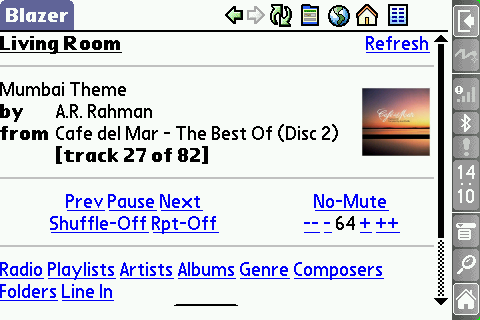Sonos - now we are talking
by Volker Weber
In many respects the Sonos solution is proprietary and closed. For instance, it cannot join an existing WLAN. It sets up its own mesh network using the same channels that WLANs use, and wisely enough it only uses channels 1, 6 and 11. There are probably good reasons for this setup, including an easier user experience for non-technical people and providing a quality of service on the net. There is also no ZonePlayer-software running of PCs or Macs, so you cannot use existing hardware in this network. Whereever you want to play music, you need a piece of hardware from Sonos. There are controllers implemented in software for Mac and Windows, allowing you to control ZonePlayers on your network.
But while the wireless network is closed and proprietary, the protocol which controls ZonePlayers is not. They all use UPnP. This allows you to write your own software to control them. The first one I found is the Sonos Web Controller:
A perl script runs and emulates a HTTP server and acts as a UPnP Control Point. The HTTP server portion handles all the requests from the UI, while the UPnP Control Point portion talks to the Sonos boxes. I did it this way because I didn't want to require Apache or some other web server to be installed. UPnP requires that a piece of software is always running to listen for UPnP Events, which is why traditional CGI software can't be used.
I installed the Web Controller on my iBook and pointed a Palm LifeDrive to its URL:

Bingo. If I run the same controller on a server and forward an external port to this machine, I could be controlling all ZonePlayers on the net from a BlackBerry.
Once you have a UPnP control point, you can start adding features to the Sonos system, like adding an alarm clock to start playing playlists at any given time through a particular ZonePlayer. You can also make the system react to other events, for instance you could pause the music when the phone rings. In that case you need to listen to your modem or an ISDN adapter and raise an event.
Now we are talking.
Sonos - first impressions
Sonos - second look
Sonos - the controller
Sonos - music from the iTunes Music Store
Sonos - now we are talking
Sonos - getting into the zone
Sonos - the mesh network
Sonos - inside the ZonePlayer
Sonos - April 10 and the ZP80 is already here
Sonos - the Wife Acceptance Factor
Comments
If the Sonos uses the standard UPnP AV and if Sonos Web Controller does not fulfill your needs, you could also try TwonkyMedia, available for about any OS. See http://www.twonkyvision.de/UPnP/index.html
Last week, I've bought the Philips SL50i, on sale for 49 Euro. It does UPnP AV and it runs with Philips Media Manager (Windows only)l. I'm trying to connect it to GMediaServer and/or ushare (both Linux).
No, Sonos does not use UPnP media servers. I have a Twonky running on the slug, and other UPnP like your Philips would work with it. Where did your get the Philips and is it still on sale?
BTW, this is a completely different market. Sonos plays in a different league with a much richer user experience.
@Volker
I've bought the Philips SL50i in a (physical) Dynabyte shop here in the Netherlands. I can't find it on www.dynabyte.nl, however.
The good news: the Dutch Dixons offers the SL50i online for 49,99 Euro. See here
I guess Philips is clearing it's warehouses (original price still shown on the web is 149 Euro), so maybe it's also on sale in Germany.
NB: IMHO, the Philips SL50i is really an entry-level model. Functionality is OK and nice for testing, but the display is small and unlit, and the remote control is huge.
It's not worth much more than 49 Euro.
Let me know if I can be of any further help.
Vowe,
There are so many options with an open UPNP controlled system. I played "Happy Birthday" to my housekeeper when she arrived in the house whilst I was actually at work.
A friend of mine is using the UPNP interface to link into Homeseer, Comfort Alarm system and CBUS.
Essentially, the CBUS control in the room can be used to send scripted commands to the Sonos system. For example, music could start when you turn the light on in the room and stop when you turn it off.
Obviously you can use the PIR sensor from the alarm system to actually see if there's anyone in the room if you wish.
So, basically you can be listening to some music and if you pop to the bathroom the music could be fed there while you go about your business and turn off with the extractor fan after you have left the room.
Anything is possible, it's quite exciting.

